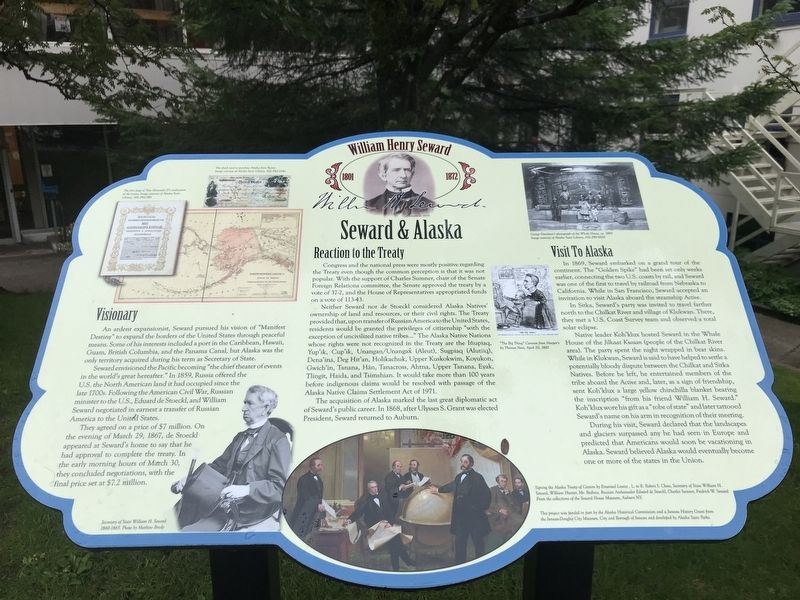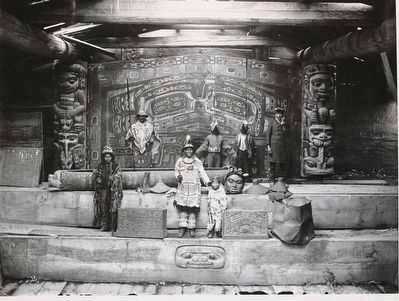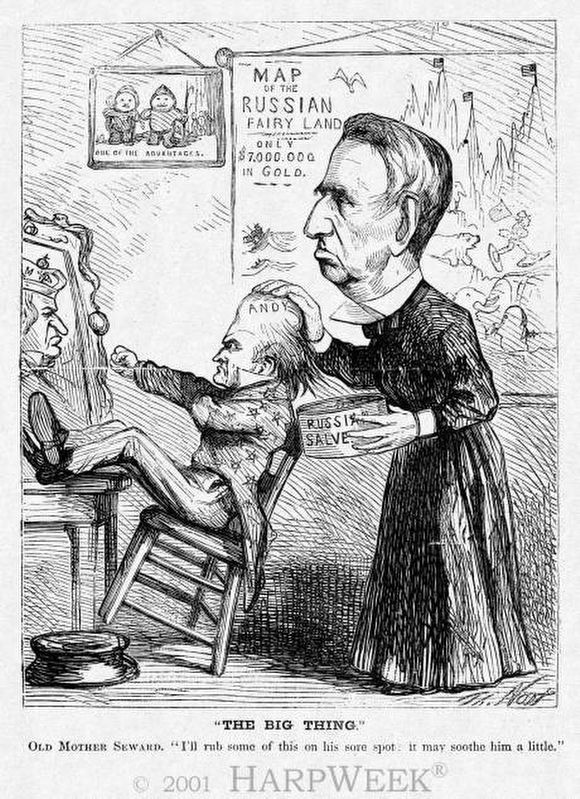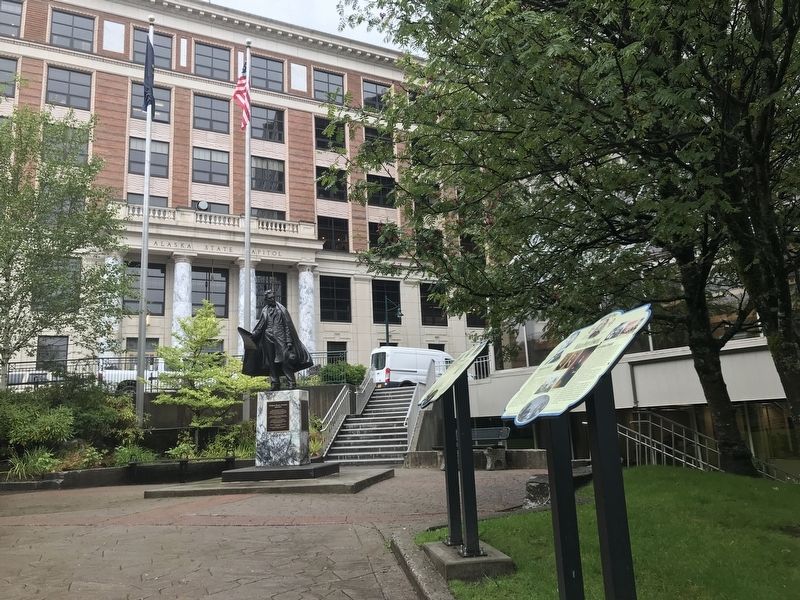Downtown Juneau in Juneau Borough, Alaska — Northwest (North America)
Seward & Alaska
Visionary
An ardent expansionist, Seward pursued his vision of “Manifest Destiny” to expand the borders of the United States through peaceful means. Some of his interests included a port in the Caribbean, Hawaii, Guam, British Columbia, and the Panama Canal, but Alaska was the only territory acquired during his term as Secretary of State.
Seward envisioned the Pacific becoming "the chief theater of events in the world's great hereafter.” In 1859, Russia offered the U.S. the North American land it had occupied since the late 1700s. Following the American Civil War, Russian minister to the U.S., Eduard de Stoeckl, and William Seward negotiated in earnest a transfer of Russian America to the United States.
They agreed on a price of $7 million. On the evening of March 29, 1867, de Stoeckl appeared at Seward's home to say that he had approval to complete the treaty. In the early morning hours of March 30, they concluded negotiations, with the final price set at $7.2 million.
Reaction to the Treaty
Congress and the national press were mostly positive regarding the Treaty even though the common perception is that it was not popular. With the support of Charles Sumner, chair of the Senate Foreign Relations committee, the Senate approved the treaty by a vote of 37-2, and the House of Representatives appropriated funds on a vote of 113-43.
Neither Seward nor de Stoeckl considered Alaska Natives' ownership of land and resources, or their civil rights. The Treaty provided that, upon transfer of Russian America to the United States, residents would be granted the privileges of citizenship "with the exception of uncivilized native tribes...” The Alaska Native Nations whose rights were not recognized in the Treaty are the Iñupiaq, Yup'ik, Cup'ik, Unangan/Unangâx (Aleut), Sugpiaq (Alutiiq), Dena'ina, Deg Hit'an, Holikachuk, Upper Kuskokwim, Koyukon, Gwich'in, Tanana, Hän, Tanacross, Ahtna, Upper Tanana, Eyak, Tlingit, Haida, and Tsimshian. It would take more than 100 years before indigenous claims would be resolved with passage of the Alaska Native Claims Settlement Act of 1971.
The acquisition of Alaska marked the last great diplomatic act of Seward's public career. In 1868, after Ulysses S. Grant was elected President, Seward returned to Auburn.
Visit To Alaska
In 1869, Seward embarked on a grand tour of the continent. The “Golden Spike” had been set only weeks earlier, connecting the two U.S. coasts by rail, and Seward was one of the first to travel by railroad from Nebraska to California. While in San Francisco, Seward accepted an invitation to visit Alaska aboard the steamship Active.
In Sitka, Seward's party was invited
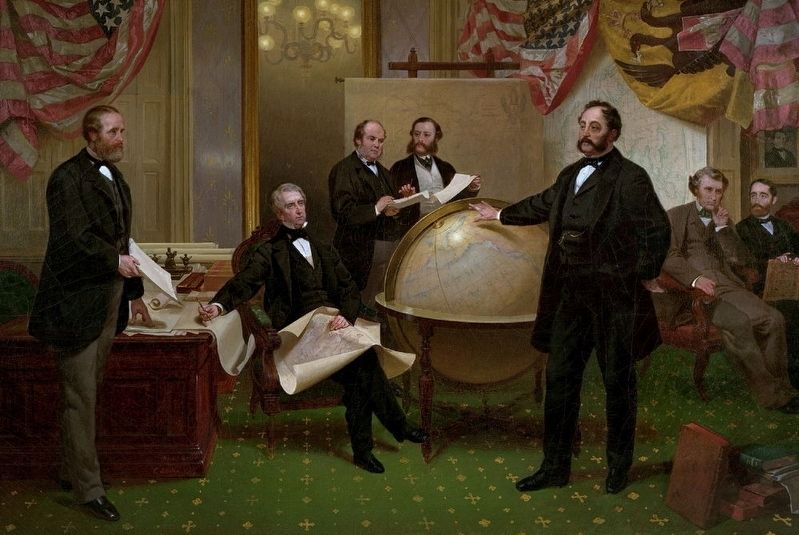
Emanuel Leutze / Public domain, 1867
2. Seward & Alaska Marker detail (original)
This idealized and historically inaccurate depiction of Russia's sale of Alaska to the United States shows (left to right): Robert S. Chew, U.S. Secretary of State William H. Seward, William Hunter, Waldemar Bodisco; Russian Ambassador Baron de Stoeckl, Charles Sumner, and Fredrick W. Seward. Chew was Seward's chief clerk; Hunter was Assistant U.S. Secretary of State; Bodisco was Russian chargé d'affaires; Sumner was a U.S. Senator from Massachusetts and chairman of the Senate Foreign Relations Committee; and Fredrick Seward was William Seward's son and an Assistant U.S. Secretary of State.
Native leader Koh'klux hosted Seward in the Whale House of the Jilkaat Kwaan (people of the Chilkat River area). The party spent the night wrapped in bear skins. While in Klukwan, Seward is said to have helped to settle a potentially bloody dispute between the Chilkat and Sitka Natives. Before he left, he entertained members of the tribe aboard the Active and, later, as a sign of friendship, sent Koh'klux a large yellow chinchilla blanket bearing the inscription “from his friend William H. Seward.” Koh'klux wore his gift as a “robe of state” and later tattooed Seward's name on his arm in recognition of their meeting.
During his visit, Seward declared that the landscapes and glaciers surpassed any he had seen in Europe and predicted that Americans would soon be vacationing in Alaska. Seward believed Alaska would eventually become one or more of the states in the Union.
Captions
(Left, top)
• The first page of Tsar Alexander Il's ratification of the treaty. Image courtesy of Alaska State Library, ASLP62-198
• The check used to purchase Alaska from Russia. Image courtesy of Alaska State Library, ASL-P62-204a
(Left, bottom) Secretary of State William H. Seward
1860-1865. Photo by Mathew Brady
(Center)
• Top: Seward in 1859
• Bottom: Signing the Alaska Treaty of Cession by Emanuel Leutze. L. to R. Robert S. Chew, Secretary of State William H. Seward, William Hunter, Mr. Bodisco, Russian Ambassador Eduard de Stoeckl, Charles Sumner, Fredrick W. Seward. From the collections of the Seward House Museum, Auburn NY.
(Right)
• Top: George Davidson's photograph of the Whale House, ca. 1893. Image courtesy of Alaska State Library, ASL P87-0010
• Bottom: “The Big Thing” Cartoon from Harper's by Thomas Nast, April 20, 1867
This project was funded in part by the Alaska Historical Commission and a Juneau History Grant from the Juneau-Douglas City Museum, City and Borough of Juneau and developed by Alaska State Parks.
Topics. This historical marker is listed in these topic lists: Native Americans • Notable Events. A significant historical date for this entry is March 30, 1867.
Location. 58° 18.1′ N, 134° 24.619′ W. Marker is in Juneau, Alaska, in Juneau Borough. It is in Downtown Juneau. Marker can be reached from the intersection of Main Street and 4th Street, on the right when traveling north. Marker is in a plaza in front of the Alaska State Capitol. Touch for map. Marker is at or near this postal address: 359 Main St, Juneau AK 99801, United States of America. Touch for directions.
Other nearby markers. At least 8 other markers are within walking distance of
this marker. William Henry Seward (here, next to this marker); a different marker also named William Henry Seward (here, next to this marker); 4-Story Totem (within shouting distance of this marker); Liberty Bell Reproduction (within shouting distance of this marker); Harvesting of the Atom (within shouting distance of this marker); Bishop Michael H. Kenny (within shouting distance of this marker); Calhoun Ave. Overpass (about 400 feet away, measured in a direct line); The MacKinnon Apartments (about 400 feet away). Touch for a list and map of all markers in Juneau.
Credits. This page was last revised on September 13, 2021. It was originally submitted on September 13, 2021, by Duane and Tracy Marsteller of Murfreesboro, Tennessee. This page has been viewed 217 times since then and 43 times this year. Photos: 1, 2, 3, 4, 5. submitted on September 13, 2021, by Duane and Tracy Marsteller of Murfreesboro, Tennessee.
